Michael Powell’s Peeping Tom and other horrors
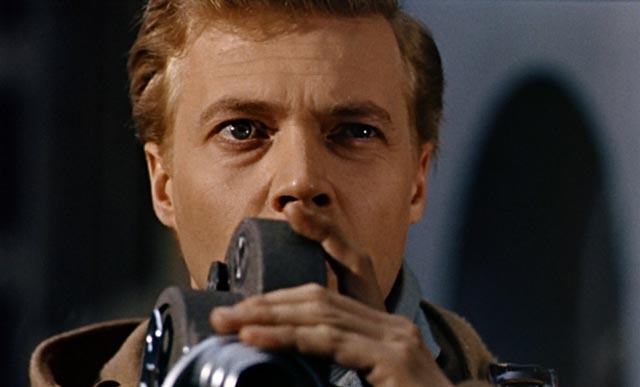
Peeping Tom (Michael Powell, 1959)
Few British filmmakers can equal the stature of Michael Powell as a creative artist; and perhaps no other British filmmaker has ever had their career ended by a masterpiece. Even Ken Russell continued to make movies for decades after the controversy surrounding The Devils (1971). But Powell was brutally savaged by the critics when Peeping Tom was released in 1960; the film got barely any release and the director made only one more feature in England before turning to episodic television work and then heading for Australia for a final pair of features – They’re a Weird Mob (1966), which reunited him with former partner Emeric Pressburger, and Age of Consent (1969), notable for a remarkably free-spirited early performance (frequently naked) by Helen Mirren.
It was a couple of decades before Peeping Tom resurfaced, thanks to the efforts of Martin Scorsese and Francis Ford Coppola, quickly being re-evaluated and recognized as a superbly crafted meditation on the nature of cinema itself, the fascination and danger of the voyeuristic gaze. Not surprisingly, the film became an important text for feminist film analysis.
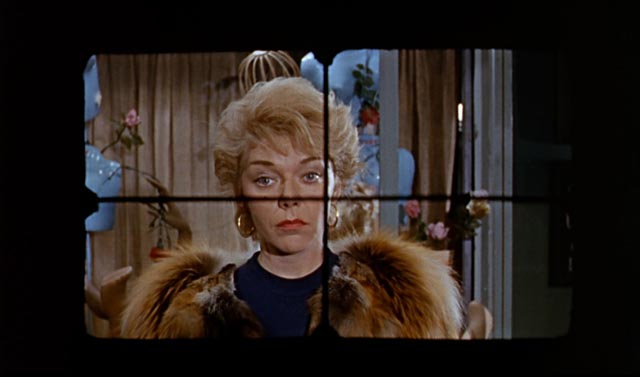
The reasons for its negative reception are examined in several extras on Optimum’s Region B Blu-ray (carried over from their earlier DVD edition). Powell had always been looked at a little suspiciously by British critics because of the visual and emotional excesses of his work in films such as Black Narcissus (1947) and The Red Shoes (1948), but by the late 1950s sheer persistence had made him something of a grand old man of British cinema, so his apparent plunge into tawdry exploitation was genuinely shocking. But it wasn’t just the twisted psychology of his protagonist, a cameraman who literally kills with the cinematic apparatus, or the obvious deviant sexuality which fuels his murders; nor the sordid settings in Soho, with prostitutes and backroom pornographic photo shoots, which disgusted the critics (and Powell’s distributor).
It was something more disturbing that set Peeping Tom apart from other condemned movies of the time – Arthur Crabtree’s Horrors of the Black Museum (1959), Sidney Hayers’ Circus of Horrors (1960). Powell, working from a very complex and tightly structured script by first-time screenwriter Leo Marks, aligns the audience inextricably with the protagonist, Mark Lewis, voyeur, pornographer and murderer. With his weapon being the camera itself, the audience inescapably participates in each murder, and yet through Karlheinz Boehm’s subtle yet emotionally intense performance and his critical involvement with his sweetly open neighbour Helen (Anna Massey), viewers go far beyond identification with the murderer to a deep empathy, a need to follow him on his quest to understand his own demons and discover the truth he’s searching for through his crimes.
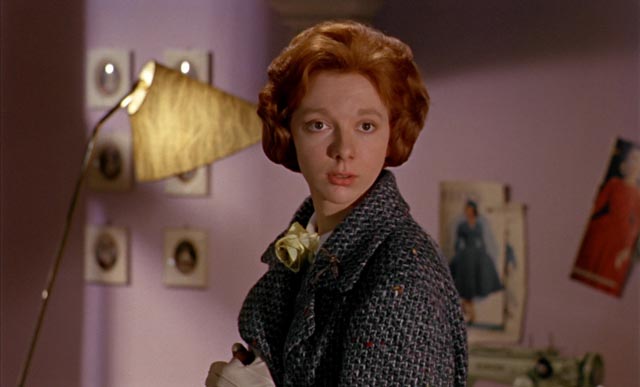
For 1960, this was a lot to ask of an audience. Although that same year Hitchcock went some way down a similar path with Norman Bates in Psycho, as is pointed out by some of the commenters on the disk, the final scene with Simon Oakland’s psychiatrist explaining Norman’s pathology at length confirms the murderer’s otherness for the audience, letting viewers who have relished the film’s thrills leave the theatre confident that whatever his problem was, they didn’t share it. Peeping Tom refuses to provide that escape hatch and as it ends the viewer is left with that very uncomfortable sense of identification, the feeling that in some ways Mark is all too much like the rest of us, and we like him.
The restored image on Optimum’s Blu-ray is both lush and gaudy. The richness of Technicolor has been supplanted here by the grainy thickness of Eastmancolor, with saturated reds popping against earth tones. (Gary Tooze at DVDBeaver is incensed by what he sees as excessive DNR, but I confess the image doesn’t look to me as artificially waxy as he asserts.) In a sense you can see Powell reinventing himself, replacing the classicism of his previous work with something more raw and contemporary – the foregrounding of the apparatus (Mark’s lightweight 16mm hand-wound camera) leads to a verite approach to the murders and his recording of the aftermath as crowds watch bodies being taken away and police at work; the camera is both weapon and shield, providing Mark with anonymity in the crowd as just another member of the media drawing on sensational events. Not just up-to-the-minute, Powell was perhaps about a decade ahead of the times, his cinematic self-awareness more recognizable in films of the late-’60s and ’70s than at the end of the ’50s.
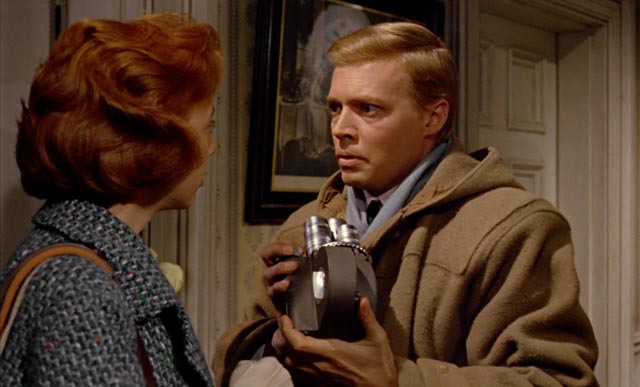
Carried over from the earlier DVD edition is Ian Christie’s enthusiastic and informative commentary; a short introduction by Martin Scorsese; a couple of documentaries – Eye of the Beholder, with interviews with Christie, Laura Mulvey, Scorsese and Powell’s widow, editor Thelma Schoonmaker; and The Strange Case of Mark Lewis, a French program featuring interviews with Bertrand Tavernier and film historian Charles Drazin among others. There’s also a separate new interview with Schoonmaker about the impact of the film’s reception on Powell; and a restoration comparison.
*
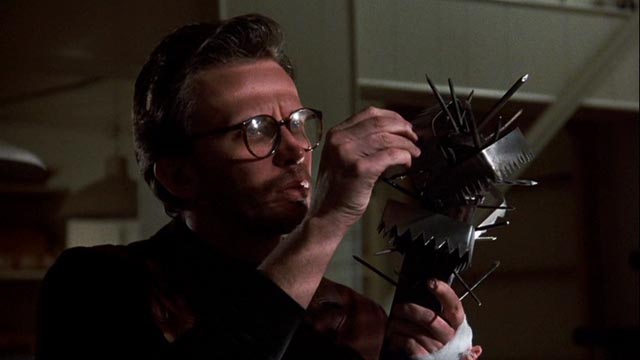
Minor horrors
I have a taste for low-budget genre movies, at least partly because inventive filmmakers often find ingenious ways to get around budgetary limitations. But it’s true that limited budgets and, even more, limited creative abilities can make a dumb idea even dumber in the execution. Although giant animal threats can be entertaining, technical limitations (before the advent of CGI) make this one of the toughest genres to bring off successfully, as evidenced by George Pan Cosmatos’ Of Unknown Origin (1983) and William F. Claxton’s Night of the Lepus (1972).
The former is an entertaining, claustrophobic story about a middle-class executive left alone in his New York townhouse when his wife and kid go away for a trip, only to find himself targeted by a giant mutant rat which settles in to take over the residence. Bart Hughes (Peter Weller) finds his life quickly falling apart, his job performance on Wall Street declining because of the distraction at home. He embarks on a war against the rodent, eventually destroying the townhouse in order to save it.
Weller gives a sweaty, committed performance, although his psychological decline occurs way too quickly, but the narrative tension is somewhat undercut by the shots of an actual rat on miniature sets … which look like a regular rat on miniature sets rather than a giant rat on a regular set.
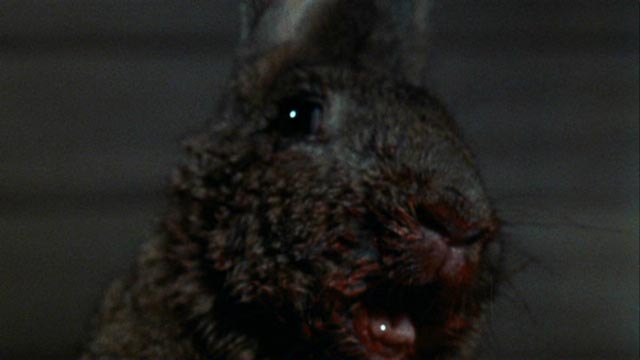
But Of Unknown Origin is a masterpiece compared to Night of the Lepus, a bizarrely incompetent adaptation of a political satire by Australian novelist Russell Braddon. Transposed to the U.S. Southwest, the satire disappears and all that’s left is an infestation of bunnies which is ruining the farmland; an ecologically-minded scientist attempts to find a biological solution, but through human stupidity a mutant strain is released from the lab and interbreeds with the wild rabbits. Before you know it, they’re growing to giant size and eating human flesh. No amount of camera trickery (miniature sets, slo-mo) can make hopping bunnies seem menacing, and the cast – headed by Stuart Whitman, Janet Leigh, DeForest Kelley and Rory Calhoun – struggle to act as if they’re in a genuinely scary movie. I wonder if Terry Jones and the rest of the Python team were inspired by this to include the killer rabbit in Monty Python and the Holy Grail three years later?
Both Scream Factory Blu-rays feature commentaries – director Cosmatos and star Weller on Of Unknown Origin, with dual tracks on Lepus from author Lee Gambin and pop culture Historian Russell Dyball – and Origin also has interviews with producer Pierre David and scriptwriter Brian Taggert.
*
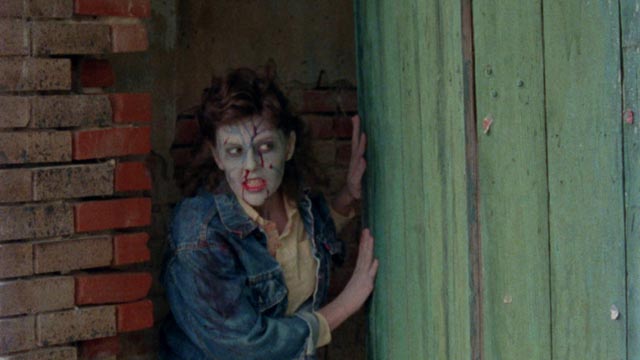
I recently dipped into the Vinegar Syndrome catalogue again for a couple of horror movies – one played straight, the other intended to be a comic send-up. The latter, Glen Coburn’s Blood Suckers From Outer Space (1984), sounds like more fun than it is. Apparently made for about five bucks in rural Texas, it has a photographer and his new girlfriend caught in what appears to be some kind of alien invasion which turns local farmers into blue-faced, blood-sucking zombies. Played for laughs rather than horror or suspense (a strategy often chosen as a way to excuse inadequate resources and technical shortcomings), it’s really not funny enough to overcome the sheer clumsiness of the direction and performances.
Ray Danton’s Psychic Killer (1975), on the other hand, plays it straight with enough confidence to get through the weak spots. Arnold Masters (Jim Hutton) is a quiet guy with a mother fixation who is wrongly convicted of murder. While inside, he learns the technique of astral projection from a fellow prisoner, allowing him to leave his body and go off hunting those who have wronged him. When he’s exonerated of the murder, he goes home to discover that his mother has since died and he settles down to nap in an easy chair while his spirit starts killing off everyone involved in his conviction –judge, jury, cops.
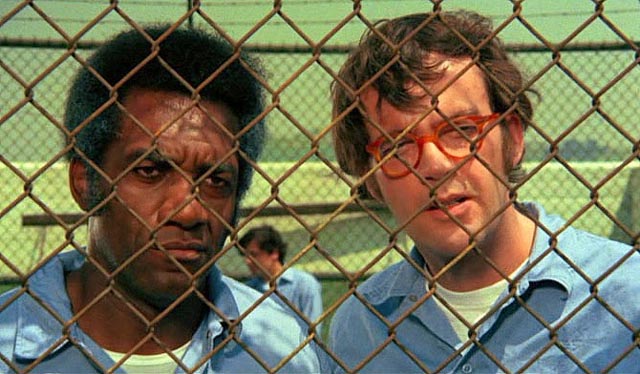
Interestingly, Arnold remains a very mild and inoffensive guy even after he starts killing; after all, he was turned into a killer by the system which decided his quiet loner tendencies were enough to convict him of murder in the first place. Reminiscent of Richard Franklin’s Patrick, made three years later, it’s a minor entry into the killers-with-psychic-powers sub-genre, aimed at a drive-in audience (there’s blood, there’s a bit of nudity), but former actor Danton (who had his best role in Budd Boetticher’s The Rise and Fall of Legs Diamond [1960]) gives it some atmosphere and instills interest in the character.
Both disks include featurettes and interviews, with a surprisingly substantial 50-minute making-of for Blood Suckers, plus a director’s commentary.
*
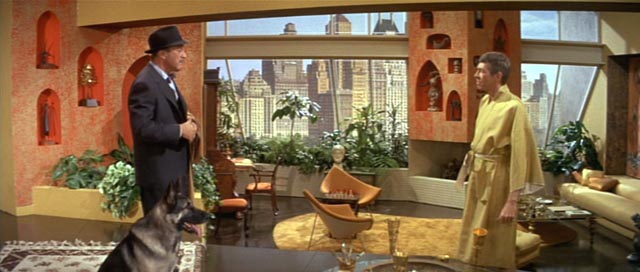
And speaking of Ray Danton – if his best role was Legs Diamond, his worst performance may well have been as Derek Flint in the abysmal made-for-TV attempt to reboot James Coburn’s character as a TV detective in Dead on Target (Joseph L. Scanlan, 1976). Included as an extra in 20th Century Fox’s Ultimate Flint Collection DVD set, this tedious made-in-Canada bomb actually has nothing to do with the two features released ten years earlier, other than appropriating the character name and trying to convince the audience that this very unappealing guy is irresistible to women.
Made as parodies of the Bond films, Our Man Flint (Daniel Mann, 1966) and In Like Flint (Gordon Douglas, 1967) made distinctive supporting player Coburn a star. Pushing the Bond image to extremes, he was super cool, super smart, super sexy and imperturbable in the face of super villains with plans to take over the world. In adhering to the formula, the movies tread a not-so-fine line between parody and sexism; his opponents are strong women who are ultimately subdued by his masculine aura. Both films are far more successful in deflating Bond’s smug, arrogant persona than the overblown Casino Royale (John Huston, Val Guest et al., 1967), but their pop-art look and sexual politics are very much of their time and may be offensive to some viewers today. Without them, however, there never would have been an Austin Powers.
The Fox set includes a number of affectionate retrospective featurettes, a pair of commentaries by film historians Eddie Friedfeld and Lee Pfeiffer … and that dire TV offshoot.
*
Back to those minor horrors I’ve been watching recently:
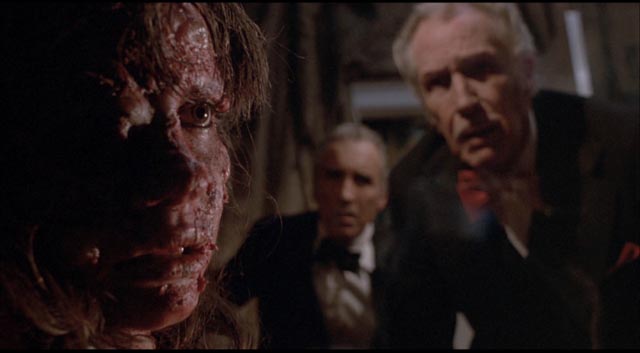
House of the Long Shadows (Pete Walker, 1983)
Following a busy (and controversial) decade which, out of a dozen productions, produced three genuine exploitation masterpieces – House of Whipcord (1974), Frightmare (1974) and House of Mortal Sin (1976) – Pete Walker took a few years off after 1979’s Home Before Midnight, but was lured back by the chance to work with a cluster of aging horror greats in a remake of Earl Derr Biggers’ old dark house chestnut Seven Keys to Baldpate. This new version, financed by Cannon Films, starred Desi Arnaz Jr as successful writer Kenneth Magee, who accepts a bet from his agent that he can bang out a new book over the weekend in a supposedly empty old mansion in Wales.
After arriving in heavy rain, Magee finds his work interrupted by an increasing number of visitors, all of whom have keys to the house despite his having been told that he was given the only one. These people include his agent’s secretary Mary (Julie Peasgood) and the entire Grisbane family, returning from the far corners of the world for a secret-haunted reunion: Lionel (Vincent Price), Sebastian (Peter Cushing), Elijah (John Carradine) and Victoria (Walker favourite Sheila Keith). Also on hand is Christopher Lee as Corrigan, who claims that he has just bought the house, and a young couple stranded by the storm. Off-screen is insane brother Roderick, who has supposedly been locked in an attic room for years.
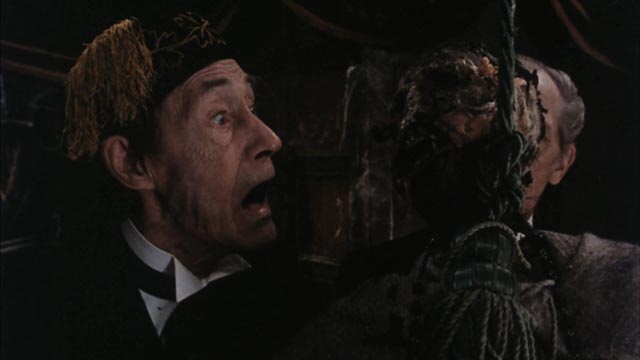
Although it’s pleasant to see the old hands amusing themselves, Arnaz is a weak lead and the whole thing is played for comedy rather than atmosphere. There’s no trace of Walker’s satirical edge, nor the nastiness of his acidic view of English society which got many of his earlier movies condemned, making this a disappointing conclusion to an interesting career. Despite having had fun with his cast, Walker abandoned the film business after this production.
The Kino Lorber Blu-ray has an on-camera interview with Walker, plus a pair of commentaries – one with Walker, the other with David Del Valle, who focuses on the stars.
*
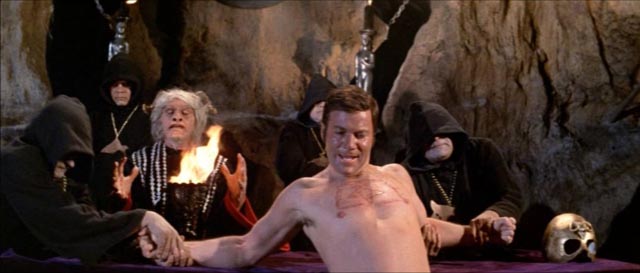
The Devil’s Rain (Robert Fuest, 1975)
Although Robert Fuest had a twenty-year career, he made only six significant theatrical features, all between 1970 and 1975. For the rest, apart from two other minor features (in 1967 and 1982), he worked in television, most notably on The Avengers (1968-69). Best known for the Art Deco comic horrors of the Dr. Phibes movies, his first horror film was the sun-drenched English-schoolgirls-in-trouble-on-a-French-holiday thriller And Soon the Darkness (1970), which he followed with a misbegotten and compromised version of Wuthering Heights (also 1970) for American International; although the company was looking for a classier image, the production was underfunded. Then came the two Phibes films (1971 and ’72), which along with Douglas Hickox’s Theatre of Blood (1973) enabled Vincent Price to reinvent himself. Then, once again with an inadequate budget, Fuest adapted Michael Moorcock’s hip sci-fi apocalypse The Final Program in 1973, a film with ambitions way beyond its means.
And then came his last feature of the period, before returning to television. Produced by Sandy Howard, who bounced between prestige productions like A Man Called Horse (1970) and utter tripe like The Neptune Factor (1973) and dull genre movies like Embryo (1976) and The Island of Dr, Moreau (the Burt Lancaster version, 1977), The Devil’s Rain (1975) shows Fuest working with weak material and investing it as best he can with some visual style and atmosphere. It’s a simple story about a family who stole from a cult the book in which members had signed away their souls to Satan, and now the cult is looking to get it back. The background is sketched in on the fly as the film opens during a raging storm out of which evil emerges. The family matriarch (Ida Lupino) is kidnapped, the old family retainer ritually strung up in the hallway by his feet, and son Mark (William Shatner) heads for the desert and a ghost town where the cult hang out.
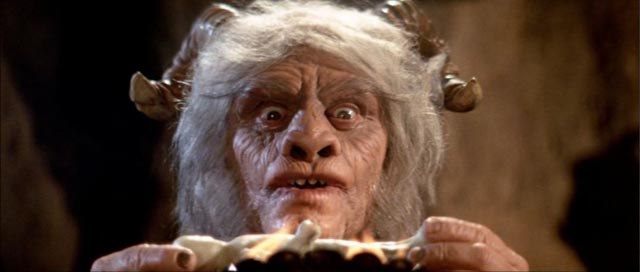
The mix of Satanism and classical western iconography gives the film an interesting flavour, and Fuest gets a controlled and menacing performance from Ernest Borgnine as Jonathan Corbis, leader of the cult (who eventually emerges as Satan himself). While the script is thin, Fuest’s direction and camerawork make it seem more substantial than it really is. But in the end, without a great deal of drama to work with, he succumbs to visual excess with a protracted sequence in which the entire cult literally melts in the titular rain. Fuest’s style almost overcomes the lack of substance, but the script stubbornly stays at the level of a made-for-TV movie.
Severin’s Blu-ray sports a good hi-def transfer and includes a commentary from Fuest as well as a number of cast and crew interviews, plus “a conversation with the High Priest and High Priestess of the Church of Satan” and an interview with Anton LeVey’s biographer.
*
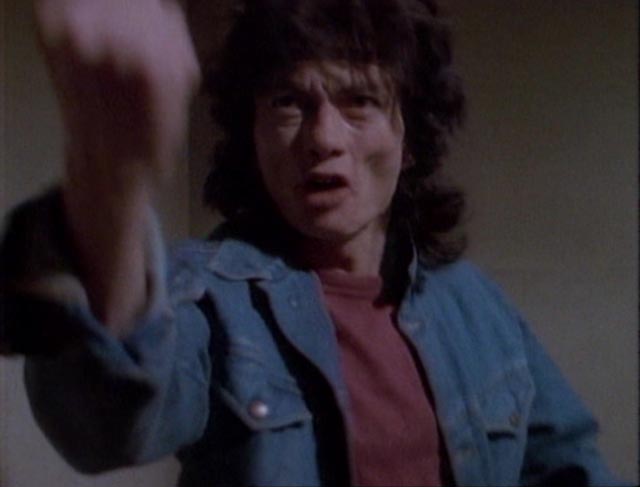
Beyond the Seventh Door (D.B. Benedikt, 1986)
And finally, a real oddity from Severin’s Intervision DVD label, Beyond the Seventh Door is packaged to look like a horror movie, but it isn’t. This extremely low-budget Canadian film was written and directed by Serbian expatriate novelist B.D. Benedikt (who apparently writes religious thrillers) in the mid-’80s, when the days of tax-shelter production were already pretty much over. With only three actors (four if you count the corpse), Benedikt makes pretty good use of some effective if minimal sets and interesting locations – particularly Toronto’s Casa Loma and a municipal water plant – to create a puzzle movie.
Recently released ex-con Boris reconnects with his unfriendly former girlfriend Wendy and persuades her to help him break into her employer’s castle to look for some treasure that’s reputed to be stashed there. Once inside, they find themselves trapped in a series of rooms, each of which has a puzzle to be solved or they’ll die. The owner seems to be playing with them sadistically, but turns out to be offering Boris a chance to make a better choice for himself. Some of the rooms are interesting, some merely perfunctory. And the movie is paced painfully slowly so it never really generates any suspense.
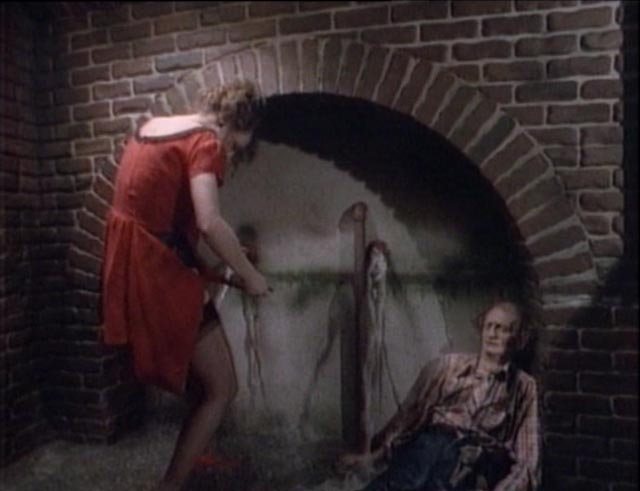
But what it does have is a hypnotically strange leading man. Boris is played by an expatriate Serbian actor named Lazar Rockwood, whose mannerisms and bizarre line readings are fascinating; I wouldn’t call it a good performance, but it does raise the movie several notches above the typical budget-challenged thriller. And Bonnie Beck provides support with a decent performance as Wendy.
I wonder whether Vincenzo Natali ever saw it, because it does feel like a sketch for Cube ten years before that debut feature.
Considering the film’s obscurity, Severin has lavished quite a bit of attention on the disk, with a commentary by director Benedikt and star Rockwood in conversation with Canuxploitation.com’s Paul Corupe, on-camera interviews with all three, plus a featurette about “Toronto eccentric” Ben Kerr who plays the corpse.
Comments